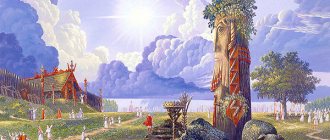Buddhism is a famous Hindu religion that has spread throughout the world today. It has more than a million followers, and its historical area is concentrated in Asia. Today, thanks to globalization, there are also quite a lot of followers in Russia.
How should Christians react to the followers of this movement and what is the attitude of Orthodoxy towards Buddhism? This can only be understood after a deep study of what kind of religion it is and what are the main differences between it and Orthodoxy.
Buddhism is a religion without God, unlike Christianity
We know and talk enough about Orthodoxy, but let’s get to know Buddhism better. The first thing to say is that Buddhism is not a religion, but a way of life.
A distinctive feature of religious traditions is the presence of an object of worship. Usually it's God. In Christianity - God the Father, among Muslims - Allah, in Zoroastrianism - Ahuramazda, etc. But not in Buddhism!
Siddhartha Gautama - Buddha and founder of Buddhism. Photo: budsvetomprod.s3.amazonaws.com
Buddhism does not claim that there is no God. He simply doesn't address the issue at all. This teaching is aimed at human development, at his attitude towards himself and the world around him.
This is a set of moral, spiritual and sometimes esoteric rules, but not religious dogmas. Buddhism is a practice, not a set of theories. Therefore, the following statements are popular:
- Buddhism is a way of life, not a religion;
- Buddhism is an atheistic religion.
All this is true and false at the same time. The correct thing to say is this: Buddhism is Buddhism. There is nothing to compare it with, it cannot be defined in Christian theological terms.
Interfaith relations: what should an Orthodox talk about with a Buddhist?
Recommendations
- ^ a b
Macmillan Encyclopedia of Buddhism, 2004, p.160 - ^ a b Encyclopædia Britannica
, 1878 Edition, article
Buddhism
by TW Rhys Davids - ^ a b c d f f Jesus: A Complete Guide by J. L. Houlden (February 8, 2006) ISBN 082648011X pages 140-144
- ^ a b c The Limits of Knowledge in Buddhism, Christianity and Science
Author: Paul D. Numrich (December 31, 2008) ISBN 3525569874 p.10 - ^ a b International Standard Bible Encyclopedia: EJ
Geoffrey W. Bromiley (March 1982) ISBN 0802837824 pages 515-516 - ^ a b c Communicating Christ in the Buddhist World
by Paul De Ney and David Lim (1 January 2006) ISBN 0878085106 p. 34 - ^ a b c Buddhism and Interfaith Dialogue
by Masao Abe and Stephen Hine (June 1, 1995) ISBN, pages 99-100 - ^ a b Mysticism, Christian and Buddhist
by Daisetz Teitaro Suzuki ((August 4, 2002)) ISBN 1605061328 p.113 - ^ a b The Historical Jesus in Recent Studies
edited by James D. G. Dunn and Scot McKnight 2006 ISBN 1-57506-100-7 p. 303 - ^ a b Jesus: The Complete Guide
2006 Leslie Houlden ISBN 082648011X p.140 - Ernest de Bunsen, The Messiah Angel of the Buddhists, Essenes and Christians (London, 1880), p. 50.
- SOURCES OF THE YEARS OF JESUS, page 65
- Crook, William (1904). Things Indian: Discursive Notes on Various Topics Related to India
. New York: Charles Scribner's Sons. item 407. Retrieved 2007-01-14. rosary india crusades. - Hinduism and Buddhism, a Historical Sketch
, Volume 3, 1921 - Chandramouli, N. S. (1 May 1997). "Did Buddhism Influence Early Christianity?" Times of India
. - Bentley, Jerry H. (1992). Intercultural Contacts and Exchanges in the Pre-Modern Era
. Oxford University Press. item 240. ISBN 978-0-19-507640-0. - Beverly, James A., "Hollywood Idol," Christianity Today
June 11, 2001 45, No. 8. Retrieved April 20, 2007. - Fouché, The Origins of Buddhist Art, p. 271
- Jesus Walking on the Sea: An Inquiry into the Origins of the Narrative
- Palmer, Martin. The Jesus Sutras: Rediscovering the Lost Scrolls of Taoist Christianity. New York: Ballantyne, 2001. pp. 241–243.
- ^ a b Buddha and Christ
Zacharias P. Thandi (1 January 1993) ISBN 9004097414 pages 95–96 - New Testament Christology, Frank J. Matera, 1999 ISBN 0-664-25694-5 p.67
- ^ a b Encyclopedia of Reincarnation and Karma
by Norman K. McClelland (April 1, 2010) ISBN 0786448512 p. 149 - Guan Xing, The Concept of Buddha
, RoutledgeCurzon, London, 2005, p. 89 - Hattori, Sho-on (2001). The Raft from the Other Shore: Honen and the Way of Pure Land Buddhism
. Jodo Shu Press. pp. 25–27. ISBN 4-88363-329-2. - ^ a b The Oxford Handbook of Eschatology by
Jerry L. Walls (April 16, 2010) ISBN 0199735883 p. 552 - The Oxford Handbook of Eschatology by
Jerry L. Walls (April 16, 2010) ISBN 0199735883 p. 151 - The Oxford Companion to Christian Thought
Adrian Hastings, Alistair Mason and Hugh Piper (21 December 2000) ISBN 0198600240 pp. 206 - Richard K. Payne (ed.), Tantric Buddhism in East Asia
, Wisdom Publications, ISBN 0861714873, 2006, p. 74 - Van Vorst, Robert E (2000). Jesus Outside the New Testament: An Introduction to the Ancient Evidence. Published by Eerdmans. ISBN 0-8028-4368-9 page 17
- Fredriksen, Paula. From Jesus to Christ
. Yale University Press, 2000, pp. xxvi.
Buddha is not a god or even a specific person
People who are far from Buddhism often ask a clarifying question: “Isn’t Buddha a god?” No, Buddha is only the level of development of a living being. Buddhist teachings tell us that we all have a spiritual nature invisible to us.
But you can really feel it during your lifetime. We can say that all people are in a material dream: they are attached to habits, things, emotions. All this controls a person. Likewise, the sleeper is not able to understand in a dream that his pursuer is only a product of the subconscious, and not a real threat.
Entrance to the Golden Abode of Buddha Shakyamuni. In such temples one does not pray, but purifies oneself, makes wishes and asks for advice from elders. Photo: cs8.pikabu.ru
A Buddha is one who has awakened to consciousness in the world of matter and remembered his true spiritual nature. The physical world is no longer the only one for him, not scary, not threatening, but only a dream, a temporary form into which the eternal soul briefly looked.
Accordingly, there is nothing significant, terrible, deadly or final.
Buddha is freed from illusions. And every person can become a Buddha. If we continue the comparison of Buddhism and Christianity, then Buddha is a kind of saint in Buddhism, but, of course, completely different, Buddhist.
Christian influence on Buddhism[edit]
Christian influence on Buddhism in the 18th and 19th centuries was primarily exemplified by modern forms of religious education. [47] [48] During recent centuries, Christian missionaries have influenced many Buddhist groups, such as the Buddhist nun Cheng Yen who, inspired by the humanitarian aid provided by Catholic nuns, decided that Buddhists needed to "do more than just encourage private cultivation souls of people." Her work eventually led to the founding of Tzu Chi, a non-profit humanitarian group in Asia. [49]
The most famous Buddha is Siddhartha Gautama
When we talk about Buddha, we most likely mean a man named Siddhartha Gautama. For Buddhism, this is a key figure, the same as Jesus Christ for Christianity.
He was born into the family of a raja of a small Indian principality in 563 or 623 BC. This was a period of decline of Vedic Hinduism, a stupor from which a way out was required. According to legend, Siddhartha Gautama could become either a great king or a saint.
563
possible year of birth of Siddhartha Gautama, founder of Buddhism
The father chose the first option for his son, imprisoned the boy in the palace and made sure that all his life he was surrounded only by positive information, luxury and comfort.
But fate decreed otherwise - the rajah’s son ended up on the street, where he saw four sights:
- an old beggar;
- sick person;
- decaying corpse;
- hermit.
Siddhartha Gautama felt shocked, because what he saw turned his ideas about the world upside down. He gave up everything, left home and indulged in ascetic practice. He spent many years in severe asceticism, from which he almost died, but was not satisfied with these searches.
There was no truth in either them or the luxury. This is how the idea of the middle path appeared: to live without extremes.
Interior of the Temple of the Emerald Buddha (Bangkok). Photo: s3.travelask.ru
Then Siddhartha Gautama sat under a tree, where he meditated for 3 days (or 49) and finally, at the age of 35, became Buddha, that is, he achieved enlightenment.
He was not the first Buddha in history, but he became the founder of Buddhism. Siddhartha Gautama had many students who have preserved to this day the knowledge that their teacher shared - what he tried himself,
↑ National religions
In the modern world there are religions that can be divided into three large groups:
.
- Tribal primitive beliefs that survive to this day
- National-state religions that form the basis of the religious life of individual nations (Judaism, Hinduism, etc.)
- World religions (Buddhism, Christianity: Catholicism, Orthodoxy, Protestantism, Islam: Sunnism, Shiism)
National
or
national-state religions
are religions that have developed within certain states or peoples.
In the modern world, many national religious beliefs coexist.
Signs of national religions
:
- arose during the formation of the early state;
- worship of the gods or the patron god of one’s people;
- the presence of complex ceremonies and rituals;
- the appearance of religious servants (priests, brahmans).
These include:
- Shintoism (Japan);
- Jainism (India);
- Confucianism (China);
- Taoism (China);
- Zoroastrianism (Iran);
- Judaism (Palestine, Israel);
- Hinduism (India) and many others.
Vegetarianism of Buddhists and Christians has different motives
Why religion is needed
Not all Buddhists are vegetarians. But still this idea prevails in this tradition. A person who eats a living creature is a murderer or an accomplice (customer) of this murder.
Buddhism has chosen a virtuous path for itself - not to cause suffering to any living thing. Accordingly, any living creature that has nerves and can experience pain, value life, etc., cannot be offended.
This is the function of man, because he is able to limit himself. Of course, no one says that such a principle should be observed by a predatory animal like a tiger. But tigers are not Buddhists, right?
Although there is an idea that next to the saint, animals become ennobled and cease to be predators.
The place where Buddha Mahasattva, out of compassion, fed himself to a tigress and her cubs. Photo: storage.yvision.kz
By the way, about tigers. One day, Buddha Mahasattva came across an emaciated tigress with cubs. He sympathized with them and, to help the unfortunate, sacrificed himself: he jumped from a cliff and crashed, giving the tiger family the meat they needed to live. This is the level of beneficence that Buddhists have towards the world.
In Orthodoxy it is more difficult. Monks do not eat meat, but they do eat fish. A number of Christian saints did not kill or eat any animals, but they exist as exceptions. The Bible shows us that before, not even wild animals killed anyone in the world.
This is a normal, healthy state of our world. So there is such an idea, but it is on the periphery, and vegetarianism of the Orthodox is more a tribute to tradition and self-restraint than an act of compassion.
Inhabitants of monasteries and their way of life
In the middle of the 19th century, a document was adopted in Russia that determined the staff of lamas (monks) and the maximum possible number of temples. It was the “Regulations on the Lamai clergy of Eastern Siberia.”
In 34 datsans, services were to be performed to 216 lamas, and their abbots, shireete, were subordinate to the main Pandito Khambo Lama.
Pandito Khamba Lama Dashi-Dorzho Itigelov
The clergy could have 34 students - huvaraka. Most of the confessors were on the church staff, but there were also supernumerary ones. They were called servants. The regulations categorically prohibited the construction of new datsans.
In addition to holding khurals - services,
rituals for believers and teaching at universities, the lamas practiced healing using the knowledge of Tibetan and Indian medicine.
Priest-doctors were called emchi. There were 60 of them in the Aginsky datsan alone.
They studied and translated medical treatises. For the treatment of believers, local herbs were collected - analogues of those that were in ancient recipes.
By the end of the 19th century, only 5 out of 34 churches were not engaged in printing. The rest conducted a brisk publishing activity, releasing:
- literature for rituals and ceremonies,
- textbooks,
- books with popular expositions of doctrine.
In total there were about 600 titles of printed products. It was mainly published in Mongolian and Tibetan languages.
The datsans possessed considerable property, both movable and immovable. The lamas' income consisted of:
- proceeds from the sale of religious objects and printed materials;
- donations from the flock in cash and in kind;
- sums of money received for renting their land and livestock;
- high interest rates for borrowed money, grain.
To become a Buddhist, it is enough to share this worldview and practice
What kind of faith do the Mongols have?
How to become a Buddhist if you are a Christian or a Jew? There is no difference who the person was before. There is no need to go through any ritual like baptism or conversion. It is enough to get to know the Buddhist worldview well and start doing basic practices: meditation and mantra reading.
It is very useful to find a group of like-minded people, some kind of Buddhist temple, where you can communicate and share experiences.
There are a lot of directions in Buddhism, all differ in details. Therefore, they may have their own initiation rituals and requirements. But in general, becoming a Buddhist is easy - just take and start living like a Buddhist: along the middle path, loving and compassionate, not hurting anything living and practicing.
Among Orthodox Christians there are different attitudes towards Buddhism
Orthodoxy does not have a consensus on Buddhism. Everything greatly depends on the position of the particular priest to whom the question was addressed. Someone will tactfully analyze the similarities and differences between Buddhism and Christianity, and then say that all religions have the right to life.
Another will perceive such a question as a personal insult. Many representatives of the Orthodox Church are annoyed that Buddhists do not believe in God the Creator, that they do not recognize the belief in hell and heaven after death, that they consider man to be a being of divine nature.
Orthodoxy has no reason to oppose Buddhism - these are religions of love.
But, as a single tradition, Orthodoxy itself says nothing about Buddhism. Only the Canaanite religion was condemned in the Bible for the fact that they made human sacrifices.
An example of an Orthodox private opinion about Buddhism can be seen in the statement of the Hieromartyr Alexander (Miropolsky):
“Buddhism can be recognized as one of the highest natural pagan religions due to its desire to understand the essence of one’s spirit, while destroying carnal passions and irresistible impressions of the sinful world.
The Buddha's struggle and mortification of the flesh led him to results that were unexpected for him: through deepening into himself, he seemed to know the essence and property of the spirit in the form in which it was embedded in his natural nature by the Creator Himself.
That is, he saw the properties of life of a higher being, the power of love for everything and compassion in suffering...
Only this self-contemplation destroyed the Buddha, for, examining himself and his spirit, he turned his gaze away from the Creator and God, and then lost all idea of Him.”
Alexander Miropolsky
martyr
But at the same time, the saint believed that such a path leads away from Christ.
But in the video below, Metropolitan Hilarion of Volokolamsk speaks warmly about Buddhism:
The relationship of Orthodoxy to Buddhism
In general, the relationship of Orthodoxy to Buddhism has no reason to be conflicting, because the characteristic feature of Buddhism is indifference to religious disputes.
Buddhism is a closed, self-sufficient world that does not try to stop other people from believing what they want.
Why I left Buddhism
Let's start with the fact that I was born into a completely secular family of atheists - my father is formally Orthodox, my mother is formally Muslim (in reality, both are atheists). I was not baptized as a child. However, my Muslim grandmother quietly taught me that God exists...
True, at the same time she did not forget to add that I should not be baptized, that being baptized is very bad. While studying in the 10th grade, I attended meetings of Evangelical Christian Baptists a couple of times, but I did not like the sermons that the pastor preached, nor did I like the pastor himself. By the time I was a student, I had formed approximately the following religious worldview: perhaps God exists, but it cannot be ruled out that God does not exist. In fact, I was an atheist.
I first became acquainted with the tenets of Buddhism and the teaching of the Eightfold Path at a paid course on extrasensory perception.
Moreover, these courses took place at one of the departments of the medical university (in our country, unfortunately, this is also possible). At these courses we were told that all religions are good, equal, and they all lead to the same goal. By the way, in these courses I learned con (which I now know is actually demonic energy), but rather mediocre. I felt how this energy was concentrated in my palms and then came out of them, but I could not use it (the “chi” energy) to achieve any practical results. It was during these same courses that I first started meditating. Later, while studying at a medical university, I used meditation during sessions: for rest and relaxation in between exams. The female associate professor who taught these courses is now teaching trainings under the same department called “lifespring” (this is a sect, but without a religious ideology).
After that, some book fell into my hands (unfortunately, I don’t remember the author), which told me that Buddhism is the most humane and best religion on earth (in contrast to the “bad” Christianity and Islam). After that, I myself began to specifically look for literature on Buddhism, and a Buddhist worldview gradually began to form in me. All this coincided with the fact that books about samurai, their bushido ethics, and books about Japan in general became popular among my classmates. Gradually this led to our introduction to Zen Buddhism. Then it turned out that I was introduced to a Japanese man (a regional representative of one of the Japanese companies). He periodically came to our city on business trips from Moscow. He taught us Zen, he taught us Zen ethics, and we meditated under his guidance. All the people who studied Zen under his leadership were in one way or another connected with the business of this company, and I was the only one in the group of these people (5 people) who was an outsider and got to them “through connections” (which I was very happy about). At that time, I sincerely considered myself a Buddhist.
It must be said that the majority of true Buddhists are not critical of their religion; they cannot be “broken” by any Orthodox anti-Buddhist sermon. Often, this is due to the fact that Buddhists do not know the whole truth about Buddhism and are not familiar with the history of Buddhism. I was like that myself. But criticism of Buddhism began to arise in me when I learned that two of my friends were in a mental hospital. They were Buddhists. Before being sent to the psychiatric hospital, they intensively practiced meditation and at the same time practiced Reiki (this is a “healing” system that originated in the depths of Japanese Buddhism). I also learned that people who practice meditation outside of Buddhism (within the framework of Krishnaism, in various versions of Indian yoga, etc.) periodically end up in a mental hospital.
A little later, while serving in a military hospital, I observed two army officers who, due to Buddhism and intense meditation, went crazy and ended up in a hospital psychiatric hospital.
I understand that ending up in a mental hospital is not the norm for Buddhists, but for me it served as the wake-up call from which I began to have critical thoughts about Buddhism. This was compounded by the fact that books about the history of Buddhism began to fall into my hands. I was surprised to learn that Buddhism is not such a “white and fluffy” religion as it is advertised. It turned out that in the history of Buddhism there was a Ja Lama who made human sacrifices to Mahakala. And his colleague Chejin Lama, during human sacrifices, entered a state of trance (he believed that at this time one of the deities - the “protectors” of Buddhism) was possessing him) and ate the hearts of these unfortunate people (that is, he engaged in cannibalism) - and all this happened in the 20th century.
The information about human sacrifices in the monasteries of Tibet also made a very unpleasant impression on me. You can read about this in one of the modern books about Tibetan Buddhism:
“On my second visit to Tibet (i.e. in the 90s of the 20th century - V.I.), I remember a conversation with teacher Tashidawa. The former chela, a young lama, told me about an ominous custom that seemed in no way compatible with the Buddhist commandment to treat any living creature with care. During the construction of religious buildings, under each of its cornerstones, a teenage lama with revealed telepathic abilities was buried alive. In the monastery where Tashidava’s parents sent him, the ceilings collapsed in 1957. While working to dismantle the ruins, the 12-year-old chela accidentally learned that he had been selected for a religious feat. He had to plunge into a state of samadhi, that is, stop his heartbeat and breathing, and lie down in a niche that was covered with a stone slab. Tashidawa fled from the monastery in horror, taking advantage of the blizzard, and only thanks to this he remained alive. Not long ago, during the restoration of the building, children's skeletons were discovered under the foundation. It is said that human remains under the cornerstones of the monasteries serve as radio beacons for telepathic contacts between the monasteries scattered among the mountains. And there is no doubt that such a wireless telegraph exists in Tibet.”
(Vsevolod Ovchinnikov. Ascension to Shambhala. M., Transitbook, 2006, pp. 95-96.)
Once, on the topic of Ja Lama and his associates, I was talking with one of my acquaintances (he is a sincere Orthodox believer). He told me that, from the point of view of Orthodoxy, the deities of Buddhism, Hinduism and other pagan religions are demons (i.e. servants of Satan), and Chejin Lama was possessed during an act of cannibalism by none other than a demon (demon) ). At the time I perceived this information rather critically, but it made me think.
Books about the history of Buddhism continued to fall into my hands. I learned that at one time there were severe persecutions of Christians (accompanied by numerous casualties) in Korea and Japan. I learned about the wars of the “Red Caps” and the “Yellow Caps” in Tibet - how they captured each other’s monasteries and forcibly converted the monks to their faith (to their branch of Buddhism). I learned that there was a kind of Buddhist inquisition in Japan. But I was once convinced that Buddhism is the most humane religion, and the Inquisition existed only in “cruel” Christianity! I also learned that when one Russian merchant asked Ja Lama how he, being a Buddhist lama, could carry weapons, fight and kill, Ja Lama replied:
“This truth (“Spare every living thing”) is for those who strive for perfection, but not for the perfect. Just as a person who has climbed a mountain must come down, so the perfect must strive down into the world - to serve for the good of others, to take upon themselves the sins of others. If a perfect person knows that a certain person can destroy a thousand of his own kind and cause disaster to the people, he can kill such a person in order to save a thousand and save the people from disaster. By murder, he will cleanse the sinner’s soul, taking his sins upon himself.”
Now, in this regard, I remember the words of Deacon Kuraev: “Buddhism is able to offer justifications for crimes committed by its adherents.”
And at the same period of my life, I was surprised to learn that the Japanese orders of ninjas (hired killers and spies) - Kogaryu and Igaryu - were actually Zen Buddhist military-spiritual orders, and the ninjas had spiritual Buddhist mentors - Yamabushi (analogous to Tibetan lamas). And these spiritual mentors did not see anything wrong with the fact that their charges earned money for their military-spiritual orders through assassination and espionage!
During the same period, books by Deacon Kuraev began to fall into my hands. From them I learned that the moral justification for the persecution of Christians in Japan was given by the Buddhist monk Suden in his treatise “On the Harm of Christianity.” This book (Sudena) fell into my hands, and I also became familiar with it (it was published in Kyiv by Ukrainian Buddhists).
All this in my mind increased my criticism of Buddhism. This criticality intensified even more when I learned the story of Shugden. Shugden is one of the spirits of Buddhism. Tibetan Buddhists worshiped him for several centuries in a row as a good, bright spirit (the “protector” of Buddhism), and then the Dalai Lama announced that Shugden was no longer worth worshiping, since Shugden was the spirit of dark forces. Information about this came to Dalailama when he was meditating again. As a result of this, the Dalai Lama himself admitted that Shugden is a demon (“dark” spirit). It turns out that for several centuries Buddhists worshiped the demon (in particular, they meditated on the image of Shugden, visualizing it in their minds!). All this time, Buddhist lamas conducted tantric initiations in relation to Shugden.
In general, from the point of view of Buddhists, Shugden is the spirit of a very real person, one of the medieval ideologists of the Tibetan Gelugpa school (school of the Ge monastery). According to legend, this man deliberately ended his life by suicide so that after death he would turn into a spirit - the “protector” of Buddhism.
However, then I was surprised to learn that, from the point of view of Orthodoxy, a person’s soul after death can be either in hell or in heaven - i.e. cannot move freely along the “astral plane”. Therefore, from the point of view of Orthodoxy, Shugden is an ordinary demon.
In general, according to the Dalai Lama, Shugden is the culprit of the Chinese occupation of Tibet and other disasters of the Tibetan people. This is what happens when the “spirit” (demon) is out of sorts! (a pun by the famous Russian Buddhologist Pavel Bunin). However, many Buddhists (for example, from the “New Kadampa Tradition” school, and not only from this school), despite the words of the Dalai Lama, continue to worship Shugden and sincerely consider this demon the “protector” of Buddhism.
At the same time, continuing to study the history and culture of Japan, I learned that within the framework of Japanese Buddhism there is a school of Shugendo, and the followers of this school are divided into two groups - shugenja - literally means “supporter of the school of Shugendo”, and yamabushi, which means "ascetic hermit" Supernatural creatures of Japanese mythology sometimes act as yamabushi. For example, the demon Saito Musashibo Benkei and the deity Sojobo are the lord of the long-nosed tengu devils that live in the mountains. Thus, the idea slowly but surely formed in my mind that the concept of “Buddhism” and the concept of “devilishness” are equivalent.
Moreover, I already knew that in Buddhism there is a “Ched” ritual (I’ll say right away that I myself have never practiced this ritual, Thank God). The “Ched” ritual consists in the fact that its practitioner comes to the cemetery at night and mentally sacrifices his body to the demons, inviting the demons to tear his body to pieces. Variations of this ritual are possible.
For example, some Tibetan Buddhists spend it at night in the mountains, and some Japanese Buddhists spend it at night on the roof of a skyscraper (is this why there are so many cases in Japan when a completely successful person is found in the morning crashed on the sidewalk under a skyscraper?!!). However, let me explain - even many Tibetan Buddhists have a very negative attitude towards this ritual and do not practice it.
Soon after I learned the story of Shugden, a friend of mine took tantric initiation. Tantric initiation in Buddhism is the taking of a vow towards wrathful deities and spirits (the “protectors” of Buddhism) and is associated with the visualization (in the mind of a Buddhist) of these deities and spirits. Tantric initiations are also practiced in the Japanese school of tantric Buddhism - Shingon. Buddhists believe that once a tantric vow has been made towards any deity or spirit, it can in no way be withdrawn. Once a lama came to our city (this visiting lama gave his lectures on Buddhism in one of the city Palaces of Culture) and told him: “In order to practice Ched more successfully, you need to take tantric initiation.” And he accepted it. After that, after a few months, he began to slowly go crazy. He lost his job, his wife left him, and finally he ended up in a mental hospital and there he almost hanged himself in the toilet (it’s good that the orderly pulled him out of the noose in time). In order to film this very tantric initiation, his relatives had to take him to the Lavra. Only there, in the Lavra, with the help of a “reprimand,” was it possible to remove this most tantric initiation. And even after the “reprimand” he had to spend several more months in the monastery, participating in the Sacraments of the Church. And I was no longer surprised that the clergy of the Lavra told this unfortunate man and his relatives that as a result of tantric initiation, demons had possessed him. Having agreed to tantric initiation - to take a vow aimed at worshiping demons - this guy himself opened the way for demons into his soul. Later, after returning home from the monastery, everything in his life seemed to return to normal. This story got me thinking again.
I soon learned that, from the point of view of Orthodoxy, visualizations practiced by Buddhists (and not only Buddhists) during meditation are a direct road to demonic seduction, to demonic possession.
All these thoughts about demonism and Buddhism coincided with the fact that I could not find the truth in Buddhism. I read Buddhist literature, read secular books about Buddhism, talked with other Buddhists, but I could not find the truth in Buddhism. In general, when studying Buddhism, one can come to the conclusion that not a single Buddhist school has ever been considered by its ideologists as a teaching that proclaims the ultimate truth. The Buddhist view in general is that truth cannot be comprehended using ordinary cognitive (epistemological) methods, nor described in ordinary mental categories, nor expressed by ordinary descriptive methods (such as the Orthodox Creed). In a word, neither the truth within the framework of Buddhism, nor all of Buddhism as a whole can be understood with the mind, according to the teachings of the ideologists of Buddhism themselves.
By comparison, Christian theology has a section called “apologetics.” This branch of Christian theology deals with the defense and justification of its doctrine with the help of reason-oriented, logical arguments.
Even the concept of “nirvana” (“nibbana”) in the same school of Buddhism is often given different formulations, and all these formulations are not considered the ultimate truth.
It may be objected to me that the criterion of truth in Buddhism is a person’s personal spiritual experience. However, according to the teachings of various Buddhist schools, a person’s personal spiritual experience, in turn, cannot be an absolute criterion of truth.
Of course, we can agree that any description of truth does not express its entirety. But no person capable of logical reasoning will ever agree that the existing expression of objective reality is not true only because it is a description of truth using alphabetic signs, and not the truth itself. Of course, provided that “truth” is understood as objective reality and its description is adequate to reality. Conventional descriptive methods cannot reflect the entirety of the truth, but this does not mean that everything reflected by conventional descriptive methods (and before all this was described, people came to these conclusions using ordinary mental categories) is false by definition.
The well-known Orthodox apologist V.Yu. Pitanov writes about this: “If this is so, then Buddhists will have to throw away all books devoted to Buddhism. If not a single Buddhist teaching “proclaims the ultimate truth”, and the main source of truth for Buddhists is their personal spiritual experience, which, as already indicated above, in turn cannot act as an absolute criterion of truth, then what conclusions from can this be done? In our opinion, the conclusion is obvious: Buddhism has no reliable criteria for truth..."
All my thoughts about Buddhism began to overlap with the fact that I couldn’t shake the feeling that I was living somehow incorrectly, that I needed to live somehow differently. As I already said, I could not find the truth in Buddhism. From time to time I experienced what seemed to me to be causeless depressions. I liked my job, but for some reason I lost the meaning of life. I led a rather interesting, not boring life - I studied NLP (neuro-linguistic programming) and used it to do “pick-up” - I met girls for a fun pastime.
In addition, I came to the conclusion (by analyzing the story of Shugden and other Buddhist “demonic” stories) that demons exist not only in our minds (as some Buddhists believe), but also exist in reality. After all, even the Dalai Lama admitted that the demon Shugden is the culprit of the Chinese occupation of Tibet and other disasters of the Tibetan people. If we consider that Shugden exists only in the minds of Buddhists, then how could it become the cause of the misfortunes of an entire people?! Then I remembered that, according to Christian doctrine, demons (demons) are the servants of Satan. As a result, I began to come to the conclusion that if Satan and demons exist, then their antagonist, the Creator God, probably also exists. If anyone doesn’t know, Buddhists do not recognize the existence of God the Creator; they believe that our Universe has always existed. Therefore, Buddhism is often called an “atheistic religion.”
During this same period of my life, I had a very long conversation with one of my good friends. This wonderful man is an officer in the Russian army, a sincere Orthodox believer. Having learned about my doubts regarding Buddhism, he only began to strengthen me in them. He told me about the Orthodox view of meditation, the concept of nirvana. He again reminded me of why spiritual practices associated with the visualization of anything are so dangerous (from the point of view of Orthodoxy).
He also told me about the negative attitude of Orthodox priests to the NLP technique and to “pick-up”. From him I received books by Lossky, Andrei Kuraev, and Father Seraphim Rose about Buddhism and various “eastern” practices. I re-read the Holy Scripture again (I had previously read it as a schoolboy).
Soon, an event happened to me, as a result of which I came to the conclusion that God really exists (I will not talk about this - since this story is deeply personal).
As a result, I came to the following conclusions:
1) Finding the truth in Buddhism is simply unrealistic for a person who has not lost the ability to reason logically.
2) The concepts of “Buddhism” and “devilishness” are equivalent concepts.
3) I also came to a conclusion that was perfectly formulated by I.M. Kontsevich and V.A. Kozhevnikov: “It becomes gloomy and creepy when you come into contact with Buddhism, although the latter dresses itself in the toga of greatness. It leads a person to the greatest sin - the sin of spiritual suicide, the eternal separation of the immortal soul from the source of life - God. It bears the stamp of proud rejection of the spirit of denial, of death.”
Here we can quote the words written by one smart person: “In the person of Buddhism, creation has forgotten and rejected its Creator and Provider, putting in its place a fatal, meaningless cycle of seemingly beginningless, blind, cosmic forces. Hence the inconsolable, incurable grief of Buddhist pessimism, this complete embodiment of the “soul without hope.”
I began to study Christian spiritual literature - both Orthodox, Catholic, and Protestant. As a result, I came to the following conclusion: true Christianity is only in Orthodoxy. In Orthodoxy I found the truth and was baptized.
Anonymous author
You can applaud the author (at least 10 times)191
It is fashionable to look for the origins of Christianity in Buddhism, but there is no basis for this
Many enthusiasts look for the roots of Christianity in Buddhism. The Jesus Prayer is their mantra; Jesus lived and studied in Tibet until the age of 30, and in general all His abilities are like those of a typical yogi.
None of these statements are based on facts. The similarity of practices is logical, because in general religious systems, to one degree or another, cannot but overlap with each other.
Images of Jesus meditating appeared due to rumors of a "Tibetan Gospel". The gross contradictions and errors in the story about this text reveal that it is a hoax. Photo: oursociety.ru
As for the story of Christ’s visit to India and Tibet, it has two sources:
- Rumors about the “Tibetan Gospel”, which have long been crushed by counterarguments.
- Bhavishya Purana, in which at the end of the 20th century a character similar to Jesus Christ was added, but until then there was no theme.
So, of course, there are parallels, but there is a lot of artificiality in them. The idea that all religions are from God has the right to life. But it does not mean at all that Christianity should be the heir of Buddhism.
We know that Eastern teachings influenced the Gnostic tradition to some extent, but it never achieved an influential position in Christendom.
By leaving a comment, you accept the user agreement
Origins and early contacts[edit]
See also: Buddhism and the Roman world and influence of Buddhism on Christianity
Bilingual edict (Greek and Aramaic) of the 3rd century BC of the Indian Buddhist king Ashoka, see Ashoka Edicts of Kandahar. This edict advocates the adoption of "piety", using Eusebean's Greek term for Dharma. Kabul Museum. Mosaic depicting the early missionary to the East Saint Francis Xavier
The history of Buddhism dates back to what is now Bodhgaya, India almost six centuries before Christianity, making it one of the oldest religions still practiced. [eleven]
The origins of Christianity go back to Roman Judea at the beginning of the first century. The four canonical gospels date from about 70–90 AD, and the epistles of Paul were written before them in about 50–60 AD. By the beginning of the second century, post-apostolic Christian theology had taken shape, in the works of authors such as Irenaeus, [12] although Christianity is seen as the fulfillment of the Jewish prophecy of the "Messiah" which goes back much further. [ citation needed
]
Beginning in the 1930s, authors such as Will Durant suggested that Emperor Ashoka's Greco-Buddhist representatives who traveled to Syria, Egypt, and Greece may have helped prepare the way for Christian teaching. [13] Buddhism was widely known in the Eastern Greek world (Greco-Buddhism) and became the official religion of the Eastern Greek successor kingdoms to the empire of Alexander the Great (Greco-Bactrian Kingdom (250 BC - 125 BC). BC) and the Indo-Greek Kingdom. Kingdom (180 BC - 10 AD)). There are several prominent Greek Buddhist missionaries (Mahadharmarakshita and Dharmarakshita) and the Indo-Greek king Menander I converted to Buddhism and is considered one of the great patrons of Buddhism. (See Milinda Panha.) Some modern historians have suggested that the pre-Christian monastic orders of Therapeuta in Egypt may have been a corruption of the Pali word "Theravada"[14], a form of Buddhism, and the movement may have taken its inspiration "almost" entirely from the teachings and practices of Buddhist asceticism." [15] They may even have been descendants of Ashoka's envoys to the West. [16]
Buddhist tombstones from the Ptolemaic period have been found in Alexandria in Egypt, decorated with images of the Wheel of Dharma, suggesting that Buddhists lived in Hellenistic Egypt at the time Christianity began. [17] The presence of Buddhists in Alexandria led one writer to remark: "Later, some of the most active centers of Christianity were founded in this very place." [15] However, modern Christian scholars generally believe that there is no direct evidence for any influence of Buddhism on Christianity, and some scholarly theological works do not support these assumptions. [18] [19] However, some historians such as Jerry H. Bentley suggest that there is a real possibility that Buddhism influenced the early development of Christianity. [20]
It is known that prominent early Christians knew about the Buddha and some Buddhist stories. Saint Jerome (4th century AD) mentions the birth of Buddha, who he says was "born of a virgin"; It has been suggested that this legend of the virgin birth in Buddhism influenced Christianity. [21] The early church father Clement of Alexandria (died 215 AD) also knew about the Buddha and wrote in his Stromata (Bk I, Ch XV): “The Indian gymnaosophists are also in this number, and other barbarian philosophers. of them there are two classes, some of them are called Sarmans, and others are Brahmins. And those of the Sarmans, who are called "Khilobiyas", do not live in cities and do not have roofs over them, but are dressed in tree bark, eat nuts and drink water from your hands. Like those who are called Encratites today, they do not know either marriage or begetting children. Some of the Indians also obey the commandments of the Buddha (Βούττα), whom they, because of his extraordinary holiness, elevated to divine honors" [22].
During the Middle Ages there was no trace of Buddhism in the West. [23] In the 13th century, international travelers such as Giovanni de Piano Carpini and William of Ruysbroeck sent reports of Buddhism to the West and noted some similarities with Nestorian Christian communities. [24] Indeed, syncretism in the East between Nestorian Christianity and Buddhism existed along the Silk Road throughout antiquity and the Middle Ages, and was particularly evident in the medieval Church of the East in China, as evidenced by the Jesus Sutras.
As European Christians made more direct contact with Buddhism in the early 16th century, Catholic missionaries such as St. Francis Xavier sent back reports of Buddhist practices. [24] With the advent of Sanskrit studies in European universities in the late 18th century and the subsequent appearance of Buddhist texts, a debate began about the proper introduction to Buddhism. [24] Over time, Buddhism gathered followers, and in the late 19th century, the first Westerners (such as Sir Edwin Arnold and Henry Olcott) converted to Buddhism, and in the early 20th century, the first Westerners (such as Ananda Metteya and Nyanatiloka) entered the Buddhist monastic life. [24]











